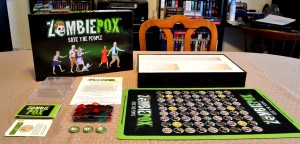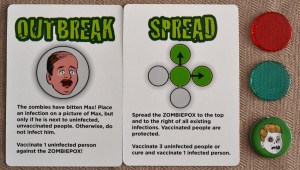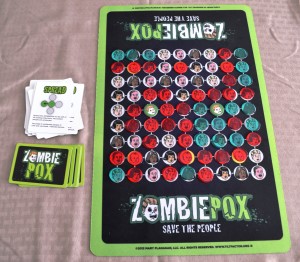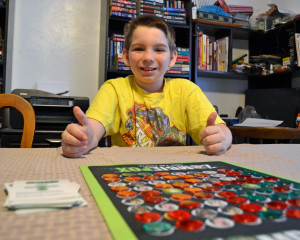I’m a sucker for zombie games, whether they be open-world post-apocolyptic survival games or themes that involve players being the zombies themselves. “ZOMBIEPOX” is neither, focusing more on zombie control and outbreak prevention. Players will be teaming up to prevent the spread of the disease (ZOMBIEPOX, hence the name) all the while vaccinating and curing as many as they can. Before we get started fighting off the undead, I’d like to thank Amanda Young from Tiltfactor for providing me with a free review copy.
Components
Game Board – The board consists of a square grid, filled with rows and columns of circular faces. These spaces represent the population of your town.
Cards – Spread cards and outbreak cards make up the “ZOMBIEPOX” card deck, which serve to spread the infection in various ways.
Chips – Chips help players to keep track of who is infected, immunized, and zombified. (Green, red, and zombie face, respectively)
Setup & Gameplay
The deck is shuffled and placed near the board, face down. A zombie chip is placed on each of the two zombie spaces on the game board. At this point, players will need to agree on the zombie tolerance level, which is how many zombies can be on the board before the game is lost. The manual suggests anywhere from two to six zombies, depending on the level of difficulty you want. The youngest player goes first.
On a player’s turn, they’ll perform the following actions:
1) Draw a card.
2) Add green infection chips as directed by the card. Spread cards will indicate a direction and outbreak cards will list a specific person. In the case of a spread card, EVERY infected person and zombie spreads the infection in the direction shown. In the case of an outbreak card, one green infection token is placed on a person matching the portrait shown.
3) Analyze the board and turn people into zombies, as appropriate. When an infected person is surrounded on all sides by infected people, a zombie token is placed on their space. The exception to this rule are yellow spaces, who represent people extremely vulnerable to infection. As soon as they become infected, they become a zombie, regardless of how many infected people are surrounding them. A zombie cannot be cured and will remain zombified until the game’s end.
4) Add red immunization chips, the number of which is determined by the card. Healthy and infected people can be immunized and in the case of the latter, the green infection chip is replaced with the red immunized chip. A person who is immunized cannot be infected for the rest of the game.
Once a player has finished their turn, play continues clockwise. Turns continue until either the disease can no longer be spread, until players run out of infection chips, or the zombie threshold value has been passed. In the case of the latter two scenarios, the game results in a loss. If you manage to satisfy the first scenario, all of the players win the game!
The above doesn’t cover all of the rules found in the manual, but should give you an idea as to how it is played. For more information, you can check out the manual and funny promotional video here:
http://www.tiltfactor.org/wp-content/uploads2/zombiepox_1stEdition_english_20121104.pdf
The Review
The components were sturdy enough and the cards were easy to shuffle. The kids had no trouble playing the game, but I had a difficult time making out the faces on the game board. My eyesight is admittedly poorer than most, so make of that as you will. The board itself is a rolled up rubber mat, the surface of which is made up of a semi-smooth texture. The chips were on the smooth side, but the texture of the mat stopped them from moving around too much, which is something I appreciated. I wasn’t crazy about the plastic cases that held the chips and cards, as they were difficult to open. I discarded them in favor of plastic baggies, which worked much better when it came time to set up or clean up the game.
The learning curve was fairly light and it didn’t take us long to catch on. Essentially, you’re all working together to stop the spread of the disease. This, it turned out, was what drew us into the game the most. There is a heavy focus on cooperation and collaboration, as the people you choose to immunize every game turn will ultimately affect how well you’re doing. Conversing with your fellow “ZOMBIEPOX” players is highly encouraged, keeping play both exciting and interesting. The cards themselves aren’t all that complex, so younger children who have an aptitude for critical thinking will be able to join in on the conversations.
Vinnie (12) is just as bad as I am when it comes to all things zombie. He’s always asking to play “Last Night on Earth” and “Rise of the Zombies!”, so when I asked him to try “ZOMBIEPOX”, he was all over it. Once he caught on to how the game was played (it didn’t take more than a few turns), he couldn’t wait to take his next one. Being a very talkative individual, he was actively conversing and coming up with the best plan of action in regard to the immunization actions. This, in my opinion, is exactly what the game was trying to accomplish and succeeded in doing so.
While I commend the cards for being easy to read and follow, having both the spread action and the immunization action on the same card limits the different ways the game can be played out. With the content of the cards always being in a fixed state, there isn’t a lot of room in which to customize your play experience. With two separate decks (one for spreading and one for immunizing), there would have been more room to mess around and try different variants.
Speaking of variants, I do think the game could stand to include some. As a group, we found the game to be much too easy, having beaten the game without any more zombie conversions (besides the starting two). Vinnie commented that the cards needed to be tougher and have more options to spread the disease…I found that I agreed. The spread cards allow you to vaccinate three healthy people or cure one infected person and I found that if you spammed the former, the disease is essentially stopped before it starts. Outbreak cards help a little, but I found it easy to surround those green chips after the initial zombies / infections were contained.
Overall, “ZOMBIEPOX” serves as a fantastic way to bring friends and families closer together. Being solely a cooperative game, there is no competing, eye-gouging, name-calling, hard feelings, and so on and so forth. I didn’t have to worry about the kids fighting with one another…quite the contrary. At the same time, what makes it a superb experience also limits the audience that it would appeal to. There just isn’t enough card types and variety to allow the game to feel exciting. “Pandemic” gave me a huge rush and made me feel like I was fighting an uphill battle…I’m sorry to say that “ZOMBIEPOX” didn’t. I can’t see gamers who love complex strategy games too interested in this one, though every person/group is different. In my opinion, it would appeal the most to those enjoy cooperative and semi-casual games. It might also serve as a nice filler for gamer groups who pull all-nighters.
The price tag gave me pause, clocking in at $25.00. I think the game is a bit overpriced for the content that it offers. Perhaps Eurogames like “Stone Age” and “Power Grid” have spoiled me when it comes to quality components, as you can find both for a little bit more on eBay. If price isn’t a concern and you enjoy cooperative games, then my advice is to give this particular game a go. “ZOMBIEPOX” is competent at what it does, but its limiting gameplay options won’t allow it to appeal to everyone.
Final Verdict: 6/10
—
—
You can learn more about and purchase “ZOMBIEPOX” by visiting the following websites:




